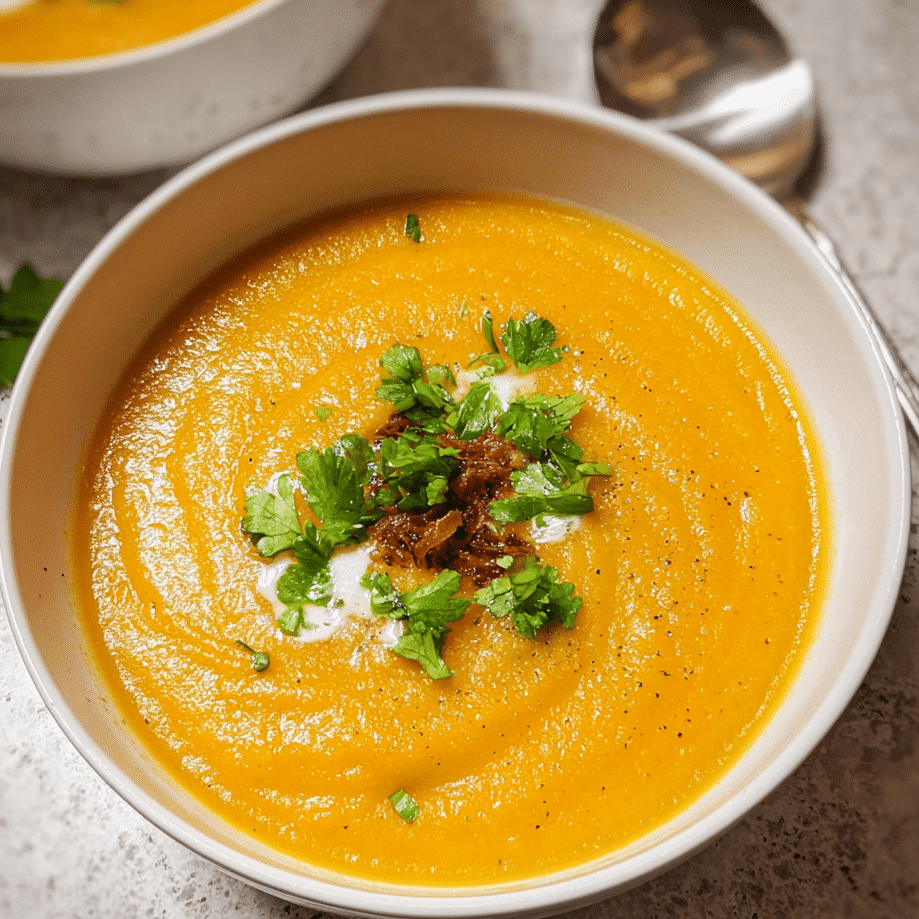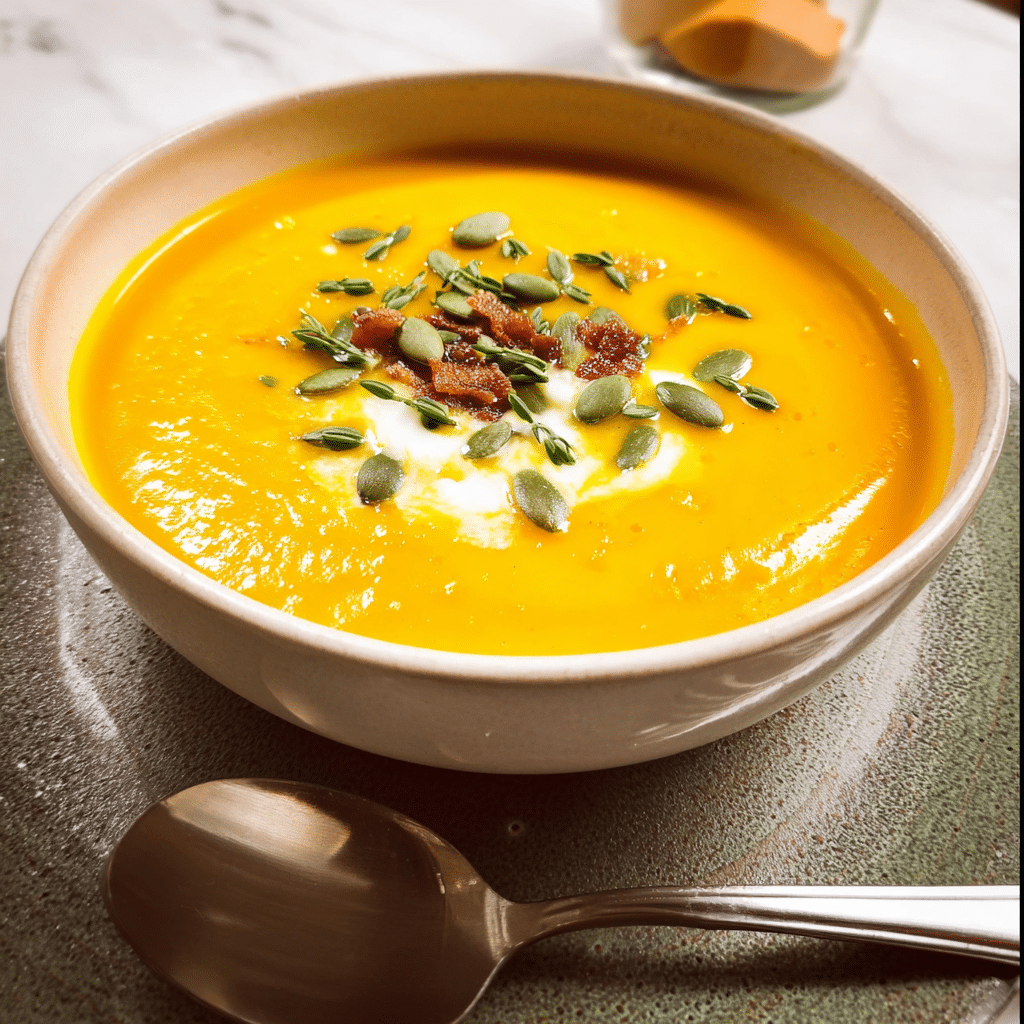Butternut squash soup is the ultimate comfort food that transforms chilly autumn evenings into warm, memorable moments around the dinner table. Are you tired of bland, watery soups that leave you feeling unsatisfied and reaching for snacks an hour later? This creamy, velvety butternut squash soup recipe promises to deliver rich, complex flavors that will have your family asking for seconds and thirds.
Hi there! I’m Lisa, the heart and soul behind Recipesrealm, and I’ve been perfecting this butternut squash soup recipe for over eight years of dedicated autumn cooking. What started as a simple seasonal experiment in my kitchen has become the most requested recipe among my family and friends. This isn’t just another soup recipe – it’s a culinary journey that celebrates the natural sweetness of butternut squash while creating layers of flavor that develop beautifully with each spoonful.
As someone who believes that food isn’t just about taste but about creating memories and sharing moments, I’ve crafted this recipe to bring warmth not only to your bowl but to your entire dining experience. Throughout this comprehensive guide, you’ll discover the secrets behind selecting the perfect butternut squash, learn professional techniques for achieving that silky-smooth texture, and explore creative variations that will keep this recipe exciting throughout the entire fall and winter season.
Why This Butternut Squash Soup Recipe Works
This butternut squash soup stands apart from ordinary recipes because it combines simplicity with sophisticated flavors that anyone can master. The magic lies in the careful balance of natural sweetness from the squash, aromatic herbs, and a secret technique that intensifies every flavor component.
• Uses affordable, seasonal ingredients: Butternut squash is budget-friendly during peak season and provides maximum nutritional value • Ready in just 45 minutes: From prep to serving, this recipe fits perfectly into busy weeknight schedules • Perfect for meal prep and entertaining: Makes generous portions that taste even better the next day and impresses dinner guests • Naturally creamy without heavy cream: Achieves restaurant-quality texture using simple blending techniques • Freezer-friendly for up to 6 months: Batch cooking made easy for cozy meals throughout winter
The roasting technique I use caramelizes the natural sugars in the butternut squash, creating depth that you simply cannot achieve with other cooking methods. This extra step transforms a good soup into an extraordinary one that rivals expensive restaurant versions.
Choosing the Right Butternut Squash for Your Soup
Selecting the perfect butternut squash is crucial for achieving the best flavor and texture in your soup. Not all squashes are created equal, and knowing what to look for can make the difference between a mediocre soup and an exceptional one.
Best Butternut Squash Selection for This Recipe
The ideal butternut squash for soup should feel heavy for its size, indicating high moisture content and dense flesh. Look for squashes with a deep, tan-colored skin that feels firm and free from soft spots. The neck portion should be long and thick, as this contains the most usable flesh with fewer seeds.
Medium-sized butternut squashes, weighing between 2-3 pounds, offer the perfect balance of flavor concentration and manageable preparation. Smaller squashes tend to have more concentrated flavor but require more prep work, while larger ones can sometimes be watery or stringy.
Buying Tips for Perfect Results
When shopping for butternut squash, examine the stem end carefully – it should be dry and slightly indented, not green or moist. A green stem indicates the squash was harvested too early and won’t have developed its full sweetness potential.
The skin should have a matte finish rather than glossy, and you should be able to scratch it lightly with your fingernail. Avoid any squash with dark spots, soft areas, or visible cracks, as these indicate deterioration that will affect your soup’s final taste.
Smart Substitutions for Butternut Squash Soup
While butternut squash creates the most traditional flavor profile, you can substitute with other winter squashes for interesting variations. Delicata squash offers a slightly nuttier flavor, while acorn squash provides earthier undertones. Kabocha squash creates an incredibly creamy texture with subtle sweetness that many find even more appealing than traditional butternut.
For those following specific dietary requirements, you can substitute up to one-third of the butternut squash with roasted sweet potatoes or carrots to reduce the natural sugar content while maintaining the soup’s signature creaminess.
Ingredients & Prep for Perfect Butternut Squash Soup
Creating exceptional butternut squash soup begins with proper ingredient selection and preparation techniques that maximize flavor development. Every component plays a specific role in building the complex taste profile that makes this recipe extraordinary.
Essential Butternut Squash Soup Prep
Start by selecting a 2-3 pound butternut squash and allowing adequate time for proper preparation. The key to achieving professional results lies in the roasting technique that caramelizes the natural sugars and concentrates the flavors.
Cut the butternut squash in half lengthwise and scoop out all seeds and stringy pulp. Score the flesh in a crosshatch pattern about ½ inch deep to promote even roasting and easier removal from the skin. Brush the cut surfaces with olive oil and season generously with salt and freshly ground black pepper.
Core Ingredients List
For the Roasted Butternut Squash:
- 1 large butternut squash (2-3 lbs)
- 2 tablespoons extra virgin olive oil
- 1 teaspoon kosher salt
- ½ teaspoon freshly ground black pepper
For the Soup Base:
- 1 large yellow onion, diced
- 3 cloves garlic, minced
- 1 medium apple, peeled and chopped
- 4 cups low-sodium vegetable broth
- 1 cup unsweetened coconut milk
- 2 tablespoons fresh ginger, grated
- 1 teaspoon ground cinnamon
- ½ teaspoon ground nutmeg
- ¼ teaspoon cayenne pepper (optional)
For Finishing:
- 2 tablespoons maple syrup
- 1 tablespoon fresh lemon juice
- Salt and pepper to taste
- Fresh herbs for garnish (sage, thyme, or parsley)
Pantry Staples for Enhanced Flavor
Keep these essential pantry items on hand to elevate your butternut squash soup from good to exceptional. High-quality vegetable broth forms the foundation of flavor, so choose brands with minimal sodium and clean ingredient lists.
Coconut milk adds richness without dairy, but you can substitute with cashew cream or even whole milk depending on your dietary preferences. The key is using full-fat versions for proper texture and mouthfeel.
Fresh ginger and warming spices like cinnamon and nutmeg complement the natural sweetness of butternut squash while adding complexity that keeps each spoonful interesting. Store whole spices in airtight containers and grind them fresh when possible for maximum flavor impact.

Step-by-Step Cooking Instructions for Butternut Squash Soup
Mastering this butternut squash soup requires attention to timing and technique, but the process is straightforward enough for beginners while offering opportunities for experienced cooks to showcase their skills.
Pre-Cooking Prep for Butternut Squash Soup
Preheat your oven to 425°F (220°C) and line a large baking sheet with parchment paper. This high temperature is crucial for proper caramelization of the butternut squash sugars, which creates the deep, complex flavor that sets this soup apart from others.
Prepare all vegetables by dicing the onion uniformly, mincing the garlic finely, and peeling and chopping the apple. Having everything ready before you begin cooking ensures smooth progression through each step without rushed preparation that can affect final results.
Place the prepared butternut squash halves cut-side down on the prepared baking sheet. The direct contact with the hot pan creates additional caramelization on the surface, intensifying the overall flavor profile.
Primary Cooking Method for Butternut Squash Soup
Roast the butternut squash for 35-45 minutes, until the flesh is completely tender when pierced with a fork and the edges show slight caramelization. The exact timing depends on the size and density of your squash, so check for doneness rather than relying solely on time.
While the squash roasts, heat 2 tablespoons of olive oil in a large, heavy-bottomed pot over medium heat. Add the diced onion and cook for 5-7 minutes until softened and lightly golden. Add the minced garlic and grated ginger, cooking for another minute until fragrant.
Add the chopped apple to the pot and cook for 3-4 minutes until slightly softened. This step allows the apple’s natural sweetness to develop and complement the butternut squash flavors.
Texture Development for Butternut Squash Soup
Once the butternut squash is cool enough to handle, scoop the flesh from the skins and add it to the pot with the aromatics. Pour in the vegetable broth gradually, stirring to combine all ingredients thoroughly.
Bring the mixture to a gentle boil, then reduce heat and simmer for 15-20 minutes to allow all flavors to meld together. The simmering process is crucial for developing the complex taste that makes this butternut squash soup memorable.
Using an immersion blender, carefully puree the soup until completely smooth and creamy. For an ultra-silky texture, strain the soup through a fine-mesh sieve, pressing the solids with the back of a spoon to extract maximum flavor.
Final Seasoning for Butternut Squash Soup
Return the strained soup to the pot and stir in the coconut milk, maple syrup, and spices. Taste and adjust seasoning with salt, pepper, and lemon juice to balance the sweetness with bright acidity.
The soup should have a velvety consistency that coats the back of a spoon without being too thick. If needed, add additional broth to reach your preferred consistency, keeping in mind that the soup will thicken slightly as it cools.
Pro Tips for Perfect Butternut Squash Soup
Achieving restaurant-quality butternut squash soup at home requires understanding several professional techniques that elevate this simple recipe into something truly special. These insider secrets come from years of experimentation and refinement.
Avoiding Common Butternut Squash Soup Mistakes
The most common mistake when making butternut squash soup is under-roasting the squash, which results in a flat, one-dimensional flavor. Proper caramelization takes time and high heat – don’t rush this crucial step even if you’re pressed for time.
Another frequent error is over-blending, which can make the soup gluey rather than creamy. Blend just until smooth, checking texture frequently to avoid over-processing the starch molecules in the vegetables.
Temperature control during cooking prevents the coconut milk from separating or curdling. Always add dairy or non-dairy milk alternatives off the heat or at very low temperatures to maintain the soup’s silky consistency.
Essential Tool Recommendations for Butternut Squash Soup
An immersion blender is invaluable for achieving the perfect texture without transferring hot soup between containers. If using a traditional blender, work in small batches and remove the center piece of the lid to prevent pressure buildup.
A fine-mesh strainer produces professional-level smoothness that distinguishes homemade soup from restaurant versions. While optional, this extra step creates a luxurious mouthfeel that justifies the additional effort.
Heavy-bottomed pots distribute heat evenly and prevent scorching, which is especially important when working with naturally sweet vegetables that can caramelize quickly on the bottom of thin pans.
Storage & Reheating Guidelines for Butternut Squash Soup
Store cooled butternut squash soup in refrigerator containers for up to 5 days, leaving space at the top for expansion. The flavors continue developing during storage, often tasting even better the second day.
For freezing, use portion-sized containers and leave 1-inch headspace for expansion. Frozen butternut squash soup maintains quality for up to 6 months and thaws beautifully when transferred to the refrigerator overnight.
When reheating, use gentle heat and stir frequently to prevent separation. If the soup appears too thick after storage, thin with additional broth or coconut milk until reaching the desired consistency.
Flavor Variations for Butternut Squash Soup
Experimenting with different flavor profiles keeps this butternut squash soup recipe exciting throughout the entire fall and winter season. These variations maintain the soup’s essential character while introducing new taste experiences that cater to different preferences and dietary requirements.
Spicy Butternut Squash Soup Variations
Transform your butternut squash soup into a warming, spicy version by incorporating jalapeño peppers or chipotle peppers in adobo sauce. Start with small amounts and build heat gradually, as the natural sweetness of the squash can mask spice levels initially.
For a Thai-inspired twist, add red curry paste, lemongrass, and lime juice to create a butternut squash soup that bridges comfort food with exotic flavors. The coconut milk base works perfectly with these Southeast Asian ingredients.
A Moroccan-spiced variation uses harissa paste, preserved lemons, and fresh cilantro to create a complex butternut squash soup that pairs beautifully with crusty bread or flatbreads.

Dietary-Friendly Butternut Squash Soup Options
Creating keto-friendly butternut squash soup requires reducing the natural carbohydrates while maintaining the creamy texture and satisfying flavors. Substitute half the butternut squash with roasted cauliflower and increase the coconut milk ratio for richness.
For paleo dieters, this butternut squash soup already meets most requirements, but ensure your vegetable broth contains no added sugars or non-compliant additives. Use ghee instead of olive oil for even richer flavor that aligns with paleo principles.
Whole30 compliant butternut squash soup omits the maple syrup and uses compliant broth and coconut milk. The natural sweetness of properly roasted butternut squash provides sufficient flavor without additional sweeteners.
International Butternut Squash Soup Flavors
| Variation Style | Key Ingredients | Flavor Profile | Serving Suggestions |
|---|---|---|---|
| Italian-Inspired | Fresh sage, parmesan, balsamic glaze | Herbaceous, nutty, tangy | Serve with crusty focaccia bread |
| Indian-Spiced | Garam masala, turmeric, ginger | Warm, aromatic, complex | Garnish with toasted coconut flakes |
| Mexican-Style | Cumin, smoked paprika, lime juice | Smoky, bright, earthy | Top with pepitas and avocado |
| French Classic | Thyme, bay leaves, crème fraîche | Elegant, refined, creamy | Accompany with herb-crusted croutons |
| Middle Eastern | Za’atar, sumac, tahini drizzle | Tangy, nutty, exotic | Serve with warm pita bread |
Serving Suggestions for Butternut Squash Soup
The perfect butternut squash soup deserves thoughtful presentation and complementary accompaniments that enhance both the visual appeal and flavor experience. Consider your audience and occasion when selecting serving styles and pairings.
Ideal Side Dishes for Butternut Squash Soup
Crusty artisanal breads provide textural contrast to the smooth soup while offering a vehicle for savoring every last drop. Sourdough, whole grain, or herb-crusted breads work particularly well with butternut squash soup’s rich flavors.
Simple green salads dressed with vinaigrette cut through the soup’s richness and add fresh, bright notes that refresh the palate between spoonfuls. Arugula, spinach, or mixed greens with dried cranberries and toasted nuts create perfect harmony.
Roasted vegetables like Brussels sprouts, carrots, or sweet potatoes extend the autumn theme while providing additional nutrients and textures that complement the butternut squash soup beautifully.
Beverage Pairings for Butternut Squash Soup
Light, crisp beverages balance the rich creaminess of butternut squash soup without overwhelming its delicate flavors. Sparkling water with fresh herbs or citrus provides palate-cleansing properties that enhance each spoonful.
Herbal teas like chamomile, ginger, or cinnamon spice complement the warming spices in the soup while providing additional comfort during cold weather dining.
For special occasions, consider serving butternut squash soup as an elegant starter course with carefully selected beverages that enhance the overall dining experience.
FAQs About Butternut Squash Soup
Understanding common questions and concerns about butternut squash soup preparation helps ensure success and addresses potential issues before they affect your final results.
Can I use pre-cut butternut squash for this soup?
Pre-cut butternut squash saves significant preparation time and works perfectly in this recipe. However, check the cut surfaces for freshness and avoid pieces that appear dried out or discolored. Fresh-cut squash from your grocery store’s produce section typically maintains quality for 3-4 days when properly stored.
The roasting technique remains the same regardless of whether you cut your own squash or use pre-cut pieces. Just ensure all pieces are roughly the same size for even cooking and optimal caramelization.
How do I fix butternut squash soup that’s too thin?
Thin butternut squash soup can be thickened using several methods without compromising flavor. Create a slurry using cornstarch and cold broth, then whisk it into the simmering soup gradually until reaching desired consistency.
Alternatively, blend a portion of cooked white beans or cashews into the soup for natural thickening that adds protein and maintains the creamy texture. Reduction through gentle simmering also concentrates flavors while thickening naturally.
Is butternut squash soup safe during pregnancy?
This butternut squash soup recipe is completely safe for pregnant women when prepared with properly washed vegetables and fresh ingredients. The high vitamin A content actually provides beneficial nutrients during pregnancy.
Ensure all vegetables are thoroughly cleaned before preparation, and store leftovers properly in the refrigerator. The soup’s natural ingredients pose no pregnancy concerns when following basic food safety guidelines.

Can I make butternut squash soup in a slow cooker?
Slow cooker butternut squash soup produces excellent results with modified technique. Roast the butternut squash in the oven first for optimal flavor development, then combine all ingredients in the slow cooker for 4-6 hours on low heat.
The extended cooking time allows flavors to develop fully, but you may need to blend the soup in batches after cooking since most immersion blenders won’t reach the bottom of slow cooker inserts effectively.
How can I reduce the sweetness in butternut squash soup?
Balance overly sweet butternut squash soup by adding acidic ingredients like lemon juice, apple cider vinegar, or tomato paste in small increments. These additions brighten the overall flavor profile without masking the squash’s natural taste.
Incorporating umami-rich ingredients like mushroom broth, miso paste, or nutritional yeast creates savory depth that counteracts excessive sweetness while maintaining the soup’s comforting character.
Conclusion
This butternut squash soup recipe represents the perfect intersection of comfort food tradition and modern nutritional awareness, creating a dish that satisfies both body and soul during the cooler months. The techniques and variations presented here offer endless opportunities to customize this recipe according to your family’s preferences and dietary requirements.
The roasting method that forms the foundation of this recipe elevates simple ingredients into something truly special, proving that exceptional cooking doesn’t require expensive or exotic components. By focusing on proper technique and quality ingredients, you can create restaurant-worthy butternut squash soup in your own kitchen.
Whether you’re preparing this butternut squash soup for a cozy family dinner, elegant entertaining, or meal prep for busy weeks ahead, the versatility and make-ahead friendly nature of this recipe makes it an invaluable addition to your autumn cooking repertoire. The warming spices and creamy texture provide comfort during cold weather while delivering impressive nutritional benefits that support healthy eating goals.
Fire up your oven and embrace the seasonal flavors that make autumn cooking so rewarding! This butternut squash soup will quickly become a beloved tradition in your household, creating the kind of food memories that last long after the last spoonful is savored.
Join the thousands of home cooks who have discovered the joy of making exceptional butternut squash soup from scratch, and don’t forget to explore our Healthy Fall Meal: Chicken Veggie Soup or Healthy Fall Salad: Quinoa Sweet Potato Kale Salad of complementary fall recipes that pair beautifully with this seasonal favorite!
If you loved this recipe, don’t forget to share it with your friends or save it to try later! I’d be thrilled to see your personal touch—share your photos on Pinterest
Print
Cozy Fall Starter: Butternut Squash Soup
- Total Time: 35 minutes
- Yield: 4 servings 1x
Description
A cozy, creamy butternut squash soup perfect for fall starters. Smooth, flavorful, and lightly spiced, this soup warms you up and makes an elegant appetizer.
Ingredients
1 medium butternut squash, peeled and cubed
1 tbsp olive oil
1 onion, chopped
2 cloves garlic, minced
4 cups vegetable or chicken broth
1/2 tsp ground nutmeg
Salt and pepper, to taste
Optional toppings: roasted pumpkin seeds, cream, fresh parsley
Instructions
1. Heat olive oil in a large pot over medium heat. Sauté onion and garlic until translucent.
2. Add cubed butternut squash, broth, nutmeg, salt, and pepper. Bring to a boil.
3. Reduce heat and simmer for 20–25 minutes, until squash is tender.
4. Use an immersion blender to puree the soup until smooth. Alternatively, transfer in batches to a blender.
5. Adjust seasoning to taste.
6. Serve hot, optionally garnished with roasted pumpkin seeds, a drizzle of cream, or fresh parsley.
Notes
For extra flavor, roast the squash before adding to the pot.
Can be made ahead and reheated gently.
Adjust thickness by adding more broth if desired.
- Prep Time: 10 minutes
- Cook Time: 25 minutes
- Category: Starter, Soup, Fall Recipe
- Method: Stovetop
- Cuisine: American
Nutrition
- Serving Size: 1 cup
- Calories: 180
- Sugar: 6g
- Sodium: 350mg
- Fat: 7g
- Saturated Fat: 1g
- Unsaturated Fat: 5g
- Trans Fat: 0g
- Carbohydrates: 28g
- Fiber: 5g
- Protein: 3g
- Cholesterol: 0mg
Keywords: Butternut Squash Soup, Fall Soup, Cozy Starter, Creamy Soup

